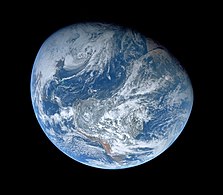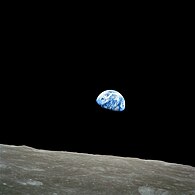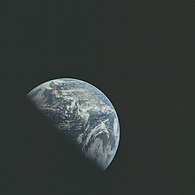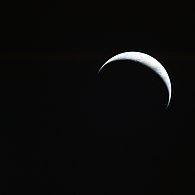Earth Phase
The Earth phase, Terra phase, terrestrial phase, or phase of Earth, is the shape of the directly sunlit portion of Earth as viewed from the Moon (or elsewhere extraterrestrially).
From the Moon, the Earth phases gradually and cyclically change over the period of a synodic month (about 29.53 days), as the orbital positions of the Moon around Earth and of Earth around the Sun shift.
 Earthrise by Apollo 8 astronaut William Anders, December 1968. Earth at gibbous phase as seen from the Moon. | |
Overview

Among the most prominent features of the Moon's sky is Earth. Earth's angular diameter (1.9°) is four times the Moon's as seen from Earth, although because the Moon's orbit is eccentric, Earth's apparent size in the sky varies by about 5% either way (ranging between 1.8° and 2.0° in diameter). Earth shows phases, just like the Moon does for terrestrial observers. The phases, however, are opposite; when the terrestrial observer sees the full Moon, the lunar observer sees a "new Earth", and vice versa. Earth's albedo is three times as high as that of the Moon (due in part to its whitish cloud cover), and coupled with the wider area, the full Earth glows over 50 times brighter than the full Moon at zenith does for the terrestrial observer. This Earth light reflected on the Moon's un-sunlit half is bright enough to be visible from Earth, even to the unaided eye – a phenomenon known as earthshine.
As a result of the Moon's synchronous rotation, one side of the Moon (the "near side") is permanently turned towards Earth, and the other side, the "far side", mostly cannot be seen from Earth. This means, conversely, that Earth can be seen only from the near side of the Moon and would always be invisible from the far side. The Earth is seen from the lunar surface to rotate, with a period of approximately one Earth day (differing slightly due to the Moon's orbital motion).
If the Moon's rotation were purely synchronous, Earth would not have any noticeable movement in the Moon's sky. However, due to the Moon's libration, Earth does perform a slow and complex wobbling movement. Once a month, as seen from the Moon, Earth traces out an approximate oval 18° in diameter. The exact shape and orientation of this oval depend on one's location on the Moon. As a result, near the boundary of the near and far sides of the Moon, Earth is sometimes below the horizon and sometimes above it.
To be aware, although genuine photographs of the Earth viewed from the Moon exist, many from NASA, some photographs shared on social media, that are purported to be the Earth viewed from the Moon, may not be real.
Phases of the Earth
- Earth phases
- Full
- Gibbous
- Low-illumination gibbous
- Very low-illumination gibbous
- Half
- High-illumination crescent
- Crescent
- Low-illumination crescent
See also
References
This article uses material from the Wikipedia English article Earth phase, which is released under the Creative Commons Attribution-ShareAlike 3.0 license ("CC BY-SA 3.0"); additional terms may apply (view authors). Content is available under CC BY-SA 4.0 unless otherwise noted. Images, videos and audio are available under their respective licenses.
®Wikipedia is a registered trademark of the Wiki Foundation, Inc. Wiki English (DUHOCTRUNGQUOC.VN) is an independent company and has no affiliation with Wiki Foundation.











